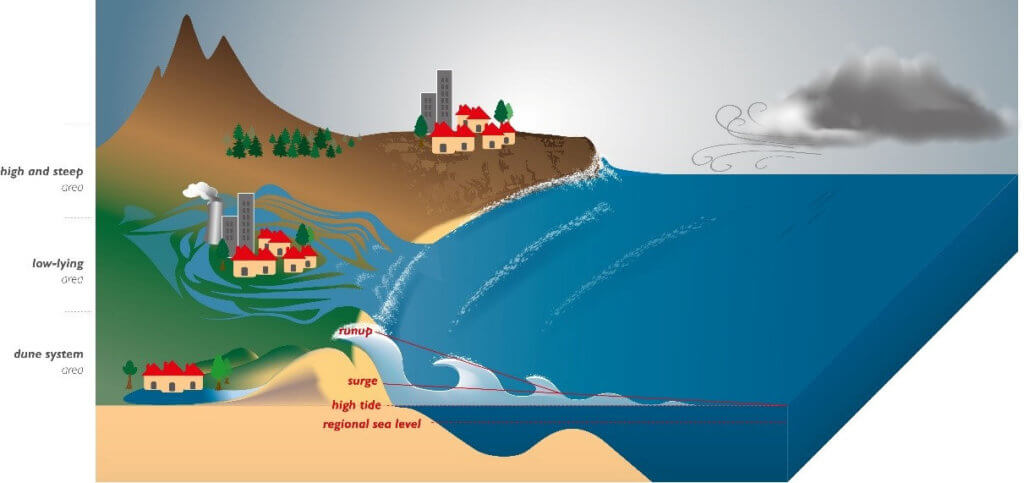MARSEILLE, France — The risk of coastal floods could rise 50-fold because of manmade climate change, according to recent research. Huge waves will hit structures or beaches with increasing frequency, say scientists, devastating communities. The weather phenomenon, known as “overtopping,” is one of scientists’ worst fears during extreme storms.
In a high emission global warming scenario, overtopping could put towns and cities across the planet underwater. One of the greatest challenges is predicting where, and how often, these monstrous waves will happen.
“The combination of tides and episodes of large waves is the main contributor to episodes of coastal overflow,” says study lead author Dr. Rafael Almar of the Institute of Research for Development, in a statement. “We identified hotspots, where the increase in risks of overtopping is higher, such as in the Gulf of Mexico, the Southern Mediterranean, West Africa, Madagascar, and the Baltic Sea.”
The French, Dutch, Brazilian, Portuguese, Italian, and Nigerian team of scientists identified the potential crisis by combining satellite data and digital models. They found coastal overtopping, and consequently flooding, is set to further accelerate over the 21st century, due to sea level rise and bigger waves.
Low-lying coastal regions host nearly 10 percent of the world’s population. In addition to ongoing erosion, these areas and their unique ecosystems are facing destructive hazards, including floods. Recent examples include Hurricane Katrina, which claimed nearly 2,000 lives and displaced one million more in 2005. In 2010, Cyclone Xynthia killed dozens of people across Europe, while Typhoon Haiyan, which hit Asia in 2013, is the largest tropical cyclone ever measured.
“These episodic events are expected to become more severe and more frequent due to global warming,” says Dr. Almar. “The consequences will also increase due to increased anthropogenic pressure, such as coastal and infrastructure development and rapid urbanization.”
The magnitude and frequency of overtapping remain uncertain. Countries in the tropics are expected to be particularly affected. Ocean waves play a significant role in determining coastal sea levels. But their contribution to flooding had previously been largely overlooked.
‘Frequency of overtopping accelerating exponentially’
Researchers used accurate topographical information and unprecedented computer simulations. This included new estimates of extreme sea levels containing tides, analysis of wind-driven waves, and existing measurements of natural and artificial coastal defenses.
The study started by quantifying the increase in global submersion events that occurred between 1993 and 2015. Satellite data was used to define two key parameters for coastal topography: the local beach slope and the maximum elevation of the coasts. The extreme level of coastal waters was calculated in hourly timesteps to identify the potential annual number of hours during which coastal defenses could be overtopped in each area.

The scientists also performed an initial assessment of the potential coastal overtopping over the 21st century, based on different sea level rise scenarios. Results show the number of overtopping hours could increase at a faster pace than the average rate of sea level rise.
“The frequency of overtopping is accelerating exponentially and will be clearly perceptible as early as 2050, regardless of the climate scenario. By the end of the century, the intensity of the acceleration will depend on the future trajectories of greenhouse gas emissions and therefore the rise in sea level,” warns Dr. Almar. “In the case of a high emissions scenario, the number of overtopping hours globally could increase fiftyfold compared with current levels. As we go along the 21st century, more and more regions will be exposed to overtopping and consequent coastal flooding, especially in the tropics, north-western United States, Scandinavia, and the Far East of Russia.”
Further studies will be needed on the local and regional levels to flesh out the projections. They provide a solid basis for proposing effective adaptation measures in the hotspots identified, adds Dr. Almar.
If global warming is limited to 3.6°F above pre-industrial levels experts predict a sea level rise of 1.6 feet by 2100. In a high-emissions scenario where warming is allowed to reach 8.1°F above pre-industrial levels, the researchers predict a rise of up to 4.3 feet by 2100.
SWNS writer Mark Waghorn contributed to this report.
